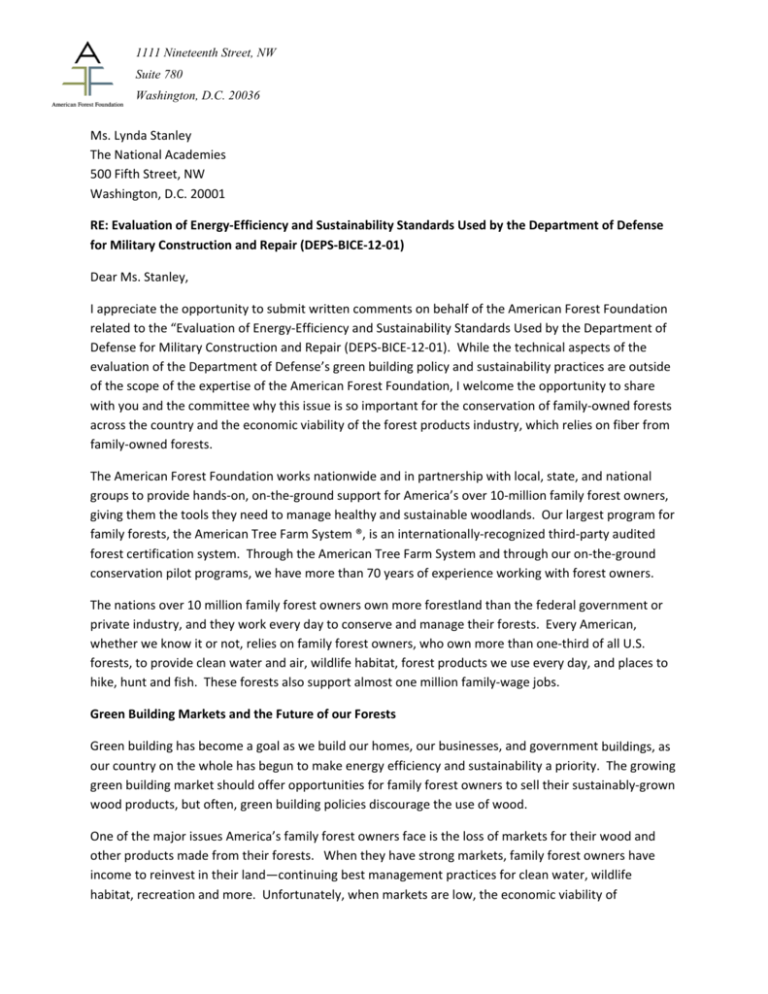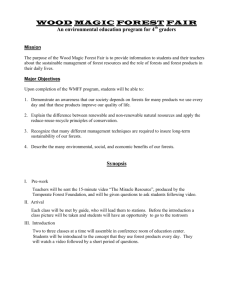comments - The American Forest Foundation
advertisement

1111 Nineteenth Street, NW Suite 780 Washington, D.C. 20036 Ms. Lynda Stanley The National Academies 500 Fifth Street, NW Washington, D.C. 20001 RE: Evaluation of Energy‐Efficiency and Sustainability Standards Used by the Department of Defense for Military Construction and Repair (DEPS‐BICE‐12‐01) Dear Ms. Stanley, I appreciate the opportunity to submit written comments on behalf of the American Forest Foundation related to the “Evaluation of Energy‐Efficiency and Sustainability Standards Used by the Department of Defense for Military Construction and Repair (DEPS‐BICE‐12‐01). While the technical aspects of the evaluation of the Department of Defense’s green building policy and sustainability practices are outside of the scope of the expertise of the American Forest Foundation, I welcome the opportunity to share with you and the committee why this issue is so important for the conservation of family‐owned forests across the country and the economic viability of the forest products industry, which relies on fiber from family‐owned forests. The American Forest Foundation works nationwide and in partnership with local, state, and national groups to provide hands‐on, on‐the‐ground support for America’s over 10‐million family forest owners, giving them the tools they need to manage healthy and sustainable woodlands. Our largest program for family forests, the American Tree Farm System ®, is an internationally‐recognized third‐party audited forest certification system. Through the American Tree Farm System and through our on‐the‐ground conservation pilot programs, we have more than 70 years of experience working with forest owners. The nations over 10 million family forest owners own more forestland than the federal government or private industry, and they work every day to conserve and manage their forests. Every American, whether we know it or not, relies on family forest owners, who own more than one‐third of all U.S. forests, to provide clean water and air, wildlife habitat, forest products we use every day, and places to hike, hunt and fish. These forests also support almost one million family‐wage jobs. Green Building Markets and the Future of our Forests Green building has become a goal as we build our homes, our businesses, and government buildings, as our country on the whole has begun to make energy efficiency and sustainability a priority. The growing green building market should offer opportunities for family forest owners to sell their sustainably‐grown wood products, but often, green building policies discourage the use of wood. One of the major issues America’s family forest owners face is the loss of markets for their wood and other products made from their forests. When they have strong markets, family forest owners have income to reinvest in their land—continuing best management practices for clean water, wildlife habitat, recreation and more. Unfortunately, when markets are low, the economic viability of Page 2 continuing stewardship practices or even continuing to own the land decreases and can lead to forest loss. Take Mimi Wright, a forest owner in southern Delaware and Maryland, for example. Mimi has been part of the American Tree Farm System since 1972. Wildlife and water quality are high priorities for Mimi, whose woodlands lie in the Chesapeake Bay Watershed. Unfortunately, all but one of the timber companies that in the past have provided her with guidance, technical assistance, and timber markets have gone out of business. Mimi says, “With them out of business, there are fewer markets for my trees, and that’s a problem. If you don’t have markets, you’re not going to have sustainable forestry.” We also hear from family forest owners, like Bill LaPoint, from Winthrop, New York. Over the past five years, Bill has been forced to sell off pieces of his forestland to pay taxes and everyday expenses. In the past, his sustainable timber harvests might have covered the costs, but the wood markets in his area are just not as strong as they once were. He has to sell the land to make ends meet. Access to a growing market, like green building, would give landowners like Mimi the resources to continue her on‐the‐ ground stewardship practices and landowners like Bill the means to keep their forestland. Current Policy Fails to Recognize Wood for Energy Efficiency and Sustainability The Department of Defense’s current green building policy, not unlike other agencies’ green building policies, does not recognize the benefits of wood for energy efficiency and sustainability and in many instances discourages builders from choosing American wood products over other building materials by preferring that builders meet the U.S. Green Building Council’s LEED rating system standards. LEED does not encourage builders to use wood products over other, less environmentally friendly materials like steel and concrete. If a builder does decide to use wood products, they can get a “certified wood credit” for using wood certified by the Forest Stewardship Council but not for wood from forests certified by the American Tree Farm System®. The American Tree Farm System is a program of the American Forest Foundation that helps 83,000 family forest owners, like Mimi and Bill, meet third‐party standards for managing nearly 26 million acres of forest land. The certified wood credit also excludes wood from Sustainable Forestry Initiative certified forests. Most certified forests in the U.S. are certified by ATFS and SFI, which severely limits the supply of certified wood eligible for builders to use to receive the “certified wood credit” toward their LEED rating. In March 2011, we saw the U.S. Department of Agriculture, Forest Service revise its green building policy to encourage construction of USDA buildings to LEED, the Green Building Initiative’s Green Globes, or other credible green building rating systems. The new policy levels the playing field and gives builders the option to use wood products in the construction of green buildings. A More Inclusive Policy Can Help the Department Meet Goals A green building policy that gives wood products a level playing field can help the Department meet its energy efficiency, sustainability, and cost goals, as our colleagues Wayne B. Trusty and Robert Glowinski with the American Wood Council will share in their comments to you. P 202.463.2462 ● F 202.463.2461 ● www.forestfoundation.org Page 3 The America Forest Foundation, through our leadership with the Forest‐Climate Working Group, convened a group of forty wood products companies, trade associations, and conservation groups, including Environmental Defense Fund, The Nature Conservancy, and Trust for Public Land to congratulate Secretary Tom Vilsack on the U.S. Department of Agriculture’s “new green building strategy and effort to promote wood as an environmentally preferable material.” The group agreed that: “[USDA’s] new initiative is an important step forward in efforts to mitigate climate change. USDA Forest Service research shows that wood products store carbon throughout their lifetime and less carbon is emitted in the processing and manufacturing of wood products, as compared to other materials.” The use of wood products in green building have direct climate benefits, but they are also an important part of keeping working forests as forests and protecting America’s landscapes. The group recognized that: “In addition to the direct climate benefits of using wood products, strong markets for wood products provide landowners with income to invest in better land management, reducing the possibility of carbon emissions from wildfires and insect and disease outbreaks. These markets also help reduce forest conversion to non‐forest uses, another source of carbon emissions.” In considering energy efficiency and sustainability practices, the evaluation should consider the entire Life Cycle Assessment, including the qualities of the materials selected for construction. When using Life Cycle Assessment to make informed decisions, wood performs better than other materials. I appreciate the opportunity to present our views on the “Evaluation of Energy‐Efficiency ad Sustainability Standards Used by the Department of Defense for Military Construction and Repair (DEPS‐ BICE‐12‐1). While the technical aspects of your study are outside of the scope of our organization, please do not hesitate to contact the America Forest Foundation if you have any questions about our views. Sincerely, Tom Martin President and CEO American Forest Foundation P 202.463.2462 ● F 202.463.2461 ● www.forestfoundation.org







